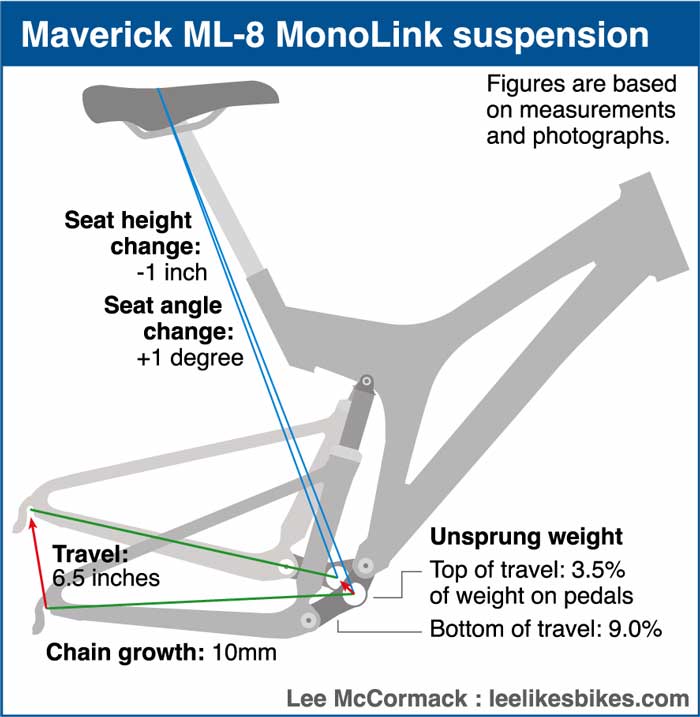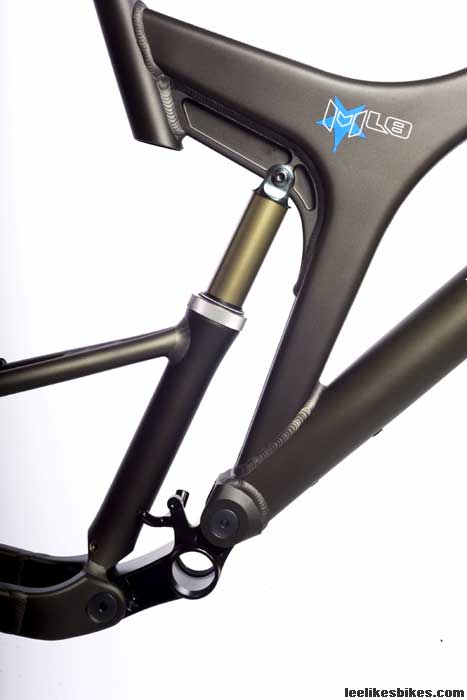Maverick ML-8

Maverick American’s ML-7 is one of the most efficient — if not the most affordable — four-inch trail bikes on the market. Maverick’s new ML-8 uses the same suspension design and boosts the rear travel to 6.5 inches. The goal: an aggressive trail bike that climbs and descends with the best of them.
 Click for big. |
Frame and Fork
Maverick’s MonoLink suspension design forms the heart of the frame. The one-piece rear triangle incorporates the shock as a structural member, and the bottom bracket rides in a link connecting the rear end to the front end. This design looks different from other popular designs, and it creates some interesting advantages and compromises.
Advantage 1: Supple suspension. The axle travels upward and backward. A rearward axle path absorbs bumps more smoothly than a vertical or forward axle path.
Advantage 2: Efficient pedaling. Pulling the chain does not move the suspension. Also, standing stiffens the suspension slightly, which theoretically will make the bike less prone to bob.
 Click for big. |
Compromise 1: Stiffer when you stand. Many old-schoolers will compare the MonoLink to the old URT designs, which pedaled very efficiently but became stiff and unresponsive when the rider weighted his pedals. At the top of the ML-8’s travel, about 3.5 percent of the rider’s weight is un-sprung; this un-sprung weight increases to about 9.0 percent at the bottom of the travel. Is this a lot? Consider that a popular URT (the Trek Y-Bike) started at about 7.2 percent and ramped up to about 10.3 percent. Considering this trait alone, the ML-8 should be more than twice as supple on small bumps as the old URTs.
Compromise 2: Chain growth. As the suspension cycles through its travel, the distance between the bottom bracket and rear axle increases. Bikes with chain growth tend to exhibit suspension feedback through the pedals, which robs power and impedes suspension performance. The ML-8’s chain grows about one centimeter, which is only about one-fourth the growth on one of the most popular seven-inch single pivot designs (the Santa Cruz Bullit).
Compromise 3: Changing seat height. As the suspension goes through its full travel, the seat angle steepens about one degree, and the seat height shortens about one inch. Of course, few of us use full travel in the saddle.
The six-inch Maverick DUC-32 fork is air sprung with a coil negative spring and weighs 3.5 pounds. The 85-millimeter rear shock, also made by Maverick, uses a coil spring with an air assist. Both employ simple shim stacks for rebound and compression damping, and both can be tuned by changing the oil height and viscosity. Maverick says the fork and shock can be serviced with simple tools.
Spec
The ML-8 is available as a frame or with two parts groups through Maverick. My bike had a custom spec. Alex Supra-D Pro rims provided burliness and gave the 2.4 WTB Mutano Raptors (my favorite dry-conditions tires> a wide footprint, but the rest of the mix was cross-country all the way: XT Hollowtech II cranks, Avid Juicy Five brakes, SRAM X.0 rear derailleur, Shimano Dura Ace triple front derailleur, Thomson seatpost and a Maverick stem. The stem is available in 70-, 90- and 105-millimeter lengths. I played with the 90 but settled on the better-handling 70 after a few rides.
The ride
 Click for big. |
It’s fun to analyze the suspension dynamics (if you’re a dork!), but there comes a time to forget about that stuff and just ride the bike. While the suspension compromises might seem major, the ML-8 excels in most riding situations.
Overall, the ML-8 climbs like a champ. It doesn’t climb well considering it has 6.5 inches of travel — it climbs well, period. The relatively light 29.5-pound weight and the fork lock-down help, but the rear suspension deserves most of the credit.
On relatively smooth ground, the rear-wheel relays power immediately. Spinning in the saddle feels as efficient as a hardtail. Standing stiffens the suspension a tad, and the ML-8 feels very responsive, like a stiff short-travel bike.
When it’s time to climb over a large obstacle, such as a two-foot rock ledge, the ML-8’s suspension works harmoniously with the rider, and it invisibly absorbs any timing errors. When the rider snaps the pedals to clear the obstacle, the bike just takes off. Braaap!
When small and medium bumps litter the trail, a rider who sits heavy on the saddle will feel the pedals kicking back and notice the seat height changing. These behaviors aren’t horrible; they’re just enough to interrupt a fluid stroke. While more neutral suspension designs (Specialized FSR), allow meatheads to churn over almost anything, the ML-8 encourages climbers to watch their lines and stay smooth.
The ML-8 descends like a champ.
The fork and shock conspire to absorb everything you throw at them. Theoretically, the rider should feel impacts through the pedals, but that isn’t the case. When the bike is ridden hard over water bars and rocks, a couple nudged zip ties are the only indication that the fork and shock are doing anything dramatic.
While the suspension does a fine job of keeping the bike glued to the ground, the ML-8 still feels very quick. Every time the rider grabs a pedal between turns, the bike shoots forward. One moment you’re splooshing through 6.5 inches of suspension, the next moment you’re sprinting like a hardtail slalom racer. Braaap!
The slack 68.5-degree head angle makes the bike feel stable, yet the low 13.7-inch bottom bracket makes it feel flick-able. The long stays and relatively short front end make the bike hard to manual and bias the rider’s weight a tad forward for steep riding. Although a good rider can adapt to these tendencies by simply shifting his weight farther back, the ML-8 feels best on flowy, not-super-steep trails.
To sum it up
I wrung out the ML-8 on my favorite cross country trails with my fastest riding partners. It climbed as well as a short-travel cross-country bike, and it descended almost as well as a heavier-duty all-mountain bike. The ML-8 suits the smooth, aggressive XC rider who wants to ride comfortably, descend confidently and climb quickly. Whether on a weekend ride, in a 24-hour event, a Super D or even in a rough cross-country race, the ML-8 will definitely hang with the best.
Details, details
Intended use: Aggressive XC
Price: Frame $2,500 + $300 for green ano. Fork $1055 with hub, upper crown and stem. As tested: $5,400. Maverick offers parts kits ranging from $4,995 to $5,850.
Weight: Complete medium bike 29.5 lbs. Large frame 6.5 pounds
Sizes: S, M, L, XL
Colors: Black, silver, green ano
Contact: (303) 415-0370; maverickamerican.com
This review ran in the June issue of Mountain Biking magazine.

Comments are closed.